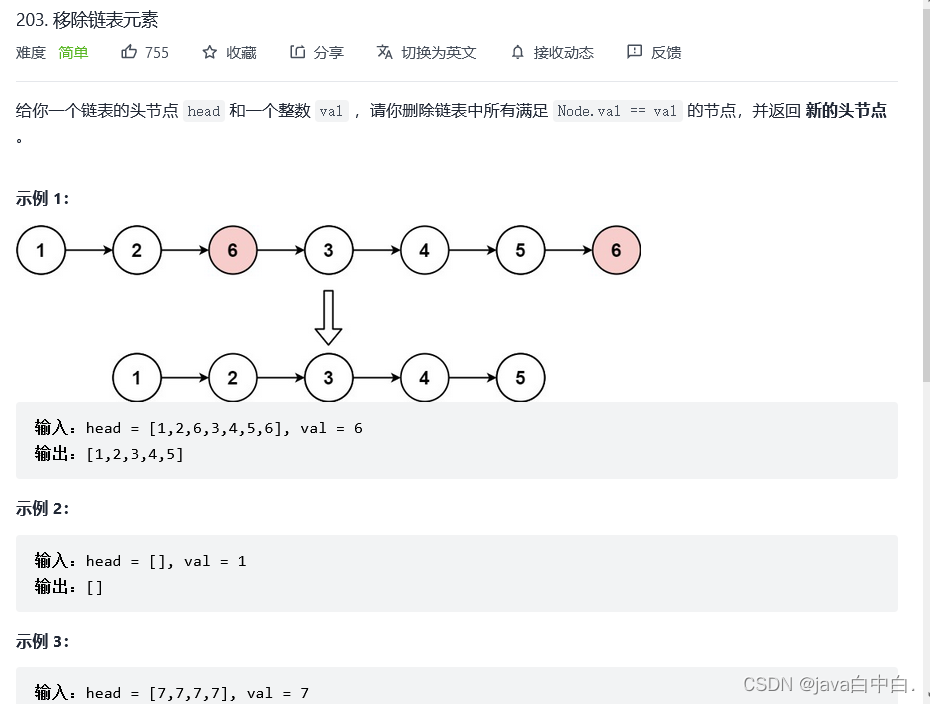LeetCode链表
这里写目录标题
- 1.[移除链表元素](https://leetcode-cn.com/problems/remove-linked-list-elements/)
- 2.[反转链表](https://leetcode-cn.com/problems/reverse-linked-list/)
- 3.[链表的中间结点](https://leetcode-cn.com/problems/middle-of-the-linked-list/)
- 4.[返回倒数第K个结点值](https://leetcode-cn.com/problems/kth-node-from-end-of-list-lcci/)
- 5.环形链表[Ⅱ](https://leetcode-cn.com/problems/linked-list-cycle-ii/)
- 6.[环形链表](https://leetcode-cn.com/problems/linked-list-cycle/)
- 7.[相交链表](https://leetcode-cn.com/problems/intersection-of-two-linked-lists/)
- 8.[回文链表](https://leetcode-cn.com/problems/aMhZSa/)
- 9.[分割链表](https://leetcode-cn.com/problems/partition-list-lcci/)
- 10.[合并两个有序链表](https://leetcode-cn.com/problems/merge-two-sorted-lists/)
1.移除链表元素
1.1 题目描述

1.2 迭代(虚拟头解决)
/**
* Definition for singly-linked list.
* public class ListNode {
* int val;
* ListNode next;
* ListNode() {}
* ListNode(int val) { this.val = val; }
* ListNode(int val, ListNode next) { this.val = val; this.next = next; }
* }
*/
class Solution {
public ListNode removeElements(ListNode head, int val) {
//使用虚拟头
ListNode dummyNode=new ListNode(0,head);
//让一个指针始终指向虚拟头,虚拟头进行迭代
ListNode l=dummyNode;
if(dummyNode.next==null){
return null;
}
while(dummyNode.next!=null){
if(dummyNode.next.val==val){
dummyNode.next=dummyNode.next.next;
}else{
dummyNode=dummyNode.next;
}
}
return l.next;
}
}
1.3 迭代(不使用虚拟头)
/**
* Definition for singly-linked list.
* public class ListNode {
* int val;
* ListNode next;
* ListNode() {}
* ListNode(int val) { this.val = val; }
* ListNode(int val, ListNode next) { this.val = val; this.next = next; }
* }
*/
class Solution {
public ListNode removeElements(ListNode head, int val) {
if(head==null){
return null;
}
ListNode l=head;
while(l.next!=null){
//如果val和头结点值相同
if(head.val==val){
head=head.next;
l=l.next;
}else if(l.next.val==val){
l.next=l.next.next;
}else{
l=l.next;
}
}
//不使用虚拟头的方式,如果链表中全部都是val元素,那么这种方式会使最后一个元素没有判断
//所以最后需要再判断一次
if(l.val==val){
return null;
}else{
return head;
}
}
}
1.4 思考
? 以后只要有链表中头结点被删除的可能,那么直接使用虚拟头的方式,非常好用!
2.反转链表
2.1 题目描述

2.2 头插法
? 这种解法需要多余的空间,如果题目的空间复杂度为O(1),那就不能使用这个解法。
/**
* Definition for singly-linked list.
* public class ListNode {
* int val;
* ListNode next;
* ListNode() {}
* ListNode(int val) { this.val = val; }
* ListNode(int val, ListNode next) { this.val = val; this.next = next; }
* }
*/
class Solution {
/**
* 使用头插法一定要注意判断什么时候是第一个节点,要初始化头节点
*/
public ListNode reverseList(ListNode head) {
//头节点
ListNode node=null;
while(head!=null){
//如果为null,则初始化头节点
if(node==null){
node=new ListNode(head.val);
}else{
ListNode newNode=new ListNode(head.val,node);
node=newNode;
}
head=head.next;
}
return node;
}
}
2.3 原地移动法
? 这种方法不需要开辟新的内存空间,适用于要求空间复杂度为O(1)的题目。
/**
* Definition for singly-linked list.
* public class ListNode {
* int val;
* ListNode next;
* ListNode() {}
* ListNode(int val) { this.val = val; }
* ListNode(int val, ListNode next) { this.val = val; this.next = next; }
* }
*/
class Solution {
public ListNode reverseList(ListNode head) {
//判断head是否为null
//判断链表中是否只有一个元素
if(head==null || head.next==null){
return head;
}
//让l指向第二个元素
ListNode l=head.next;
//链表不只有一个元素,那么就可以使用通用方法
//先让head.next=null,因为此时的head是第一个节点,反转之后成为了最后一个节点,所以head.next=null
head.next=null;
while(l!=null && l.next!=null){
//让一个引用指向l的下一个元素,防止下面操作找不到后面的元素
ListNode newNode=l.next;
//后一个元素的next指向前一个元素
l.next=head;
//前一个引用后移
head=l;
//让l找到后面的元素
l=newNode;
}
//注意:由于while的终止条件使l走到最后一个元素,并没有使其next指向前一个元素,所以这块补充指向
l.next=head;
return l;
}
}
3.链表的中间结点
3.1 题目描述

3.2 快慢指针
? 设置一个快指针和慢指针,快指针一次走两步,慢指针一次走一步。
? 若链表元素为偶数个,当快指针为null时,慢指针所指向的就是最中间元素
? 若链表元素为奇数个,当快指针的next为null时,慢指针所指向的就是最中间元素(中间第二个元素)
/**
* Definition for singly-linked list.
* public class ListNode {
* int val;
* ListNode next;
* ListNode() {}
* ListNode(int val) { this.val = val; }
* ListNode(int val, ListNode next) { this.val = val; this.next = next; }
* }
*/
class Solution {
public ListNode middleNode(ListNode head) {
ListNode low=head;
ListNode fast=head;
while(fast!=null && fast.next!=null){
fast=fast.next.next;
low=low.next;
}
return low;
}
}
4.返回倒数第K个结点值
4.1 题目描述

4.2 快慢指针
? 返回倒数第K个结点,那么就可以先让fast先走K步,然后让low和fast一块走,fast为null的时候就是要返回的那个结点值。
/**
* Definition for singly-linked list.
* public class ListNode {
* int val;
* ListNode next;
* ListNode(int x) { val = x; }
* }
*/
class Solution {
public int kthToLast(ListNode head, int k) {
//慢指针
ListNode low=head;
//快指针
ListNode fast=head;
//让快指针先跑,跑K步
for(int i=0;i<k;i++){
fast=fast.next;
}
//快指针和慢指针一块走,走到最后就是返回的那个结点
while(fast!=null){
fast=fast.next;
low=low.next;
}
return low.val;
}
}
5.环形链表Ⅱ
5.1 题目描述

5.2 解题思路

5.3 代码
5.3.1 快慢指针方法
public ListNode detectCycle(ListNode head) {
//设置快慢指针,慢指针一次走一步,快指针一次走两步
ListNode slow=head;
ListNode fast=head;
//找到快慢指针相交的地方
while(true){
if(fast==null || fast.next==null){
return null;
}
slow=slow.next;
fast=fast.next.next;
if(slow==fast){
break;
}
}
//运行到此处已经找到相交点,并且说明有循环链表,接下来使slow=head
//此时找到的相交点就是进入循环链表的起点
slow=head;
while(slow!=fast){
fast=fast.next;
slow=slow.next;
}
return fast;
}
5.3.2 方法二
public ListNode detectCycle(ListNode head) {
/*
思路:创建一个List集合,将链表上所有的结点都先放入List集合中,等到发现有结点已经存在于List集合中时,
说明这个结点是循环链表的开始之处
*/
List<ListNode> list=new ArrayList<>();
ListNode pos=head;
while(true){
if(pos==null || pos.next==null){
return null;
}
if(list.contains(pos)){
return pos;
}else{
list.add(pos);
}
pos=pos.next;
}
}
6.环形链表
6.1 题目描述

6.2 解题思路
? 和第5题一模一样,甚至比第五题还要少一个步骤,只需要判断链表是否有环即可
6.3 代码
6.3.1 快慢指针方法
public boolean hasCycle(ListNode head) {
//使用快慢指针,如果两个指针相遇,则肯定是有环链表
ListNode slow=head;
ListNode fast=head;
while(true){
if(fast==null || fast.next==null){
return false;
}
slow=slow.next;
fast=fast.next.next;
if(slow==fast){
return true;
}
}
}
6.3.2 方法二
public boolean hasCycle(ListNode head) {
//使用List集合将全部结点装进去
List<ListNode> list=new ArrayList<>();
ListNode pos=head;
while(true){
if(pos==null || pos.next==null){
return false;
}
if(list.contains(pos)){
return true;
}else{
list.add(pos);
}
pos=pos.next;
}
}
7.相交链表
7.1 题目描述

7.2 解题思路
? 要比较两个链表是否有相交部分时,那肯定是在两个链表长度相同条件下进行比较的,所以

7.3 代码
public ListNode getIntersectionNode(ListNode headA, ListNode headB) {
if(headA==null || headB==null){
return null;
}
ListNode posA=headA;
ListNode posB=headB;
while(posA!=posB){
posA=(posA==null?headB:posA.next);
posB=(posB==null?headA:posB.next);
}
return posA;
}
8.回文链表
8.1 题目描述

8.2 解题思路
- 使用快慢指针找到链表的中间元素,要注意偶数个和奇数
- 将起始元素到中间元素的所有元素存放在栈中,用于与后面的元素进行比对
- 根据链表的个数进行比对
8.3 代码
public boolean isPalindrome(ListNode head) {
//如果链表为空或者只有一个元素,那么为true
if(head==null || head.next==null){
return true;
}
//如果链表结点只有两个,直接进行判断
if(head.next.next==null){
if(head.val==head.next.val){
return true;
}else{
return false;
}
}
//快慢指针找到中间元素
ListNode slow=head;
ListNode fast=head;
//设置num初始值为0,目的是防止当链表数只有两个的时候不会被赋值
int num=0;
//将中间元素之前的所有元素放入栈中,方便与后面的所有元素进行比对
Stack stack=new Stack();
//找最中间的元素,slow将会指向最中间的元素
while(true){
stack.push(slow.val);
//链表数为奇数个
if(fast.next==null){
//奇数个元素为1
num=1;
break;
}
//链表数为偶数个
if(fast.next.next==null){
//偶数个元素为0
num=0;
break;
}
slow=slow.next;
fast=fast.next.next;
}
//链表个数为奇数
if(num==1){
stack.pop();
slow=slow.next;
while(slow!=null){
if((int)stack.pop()!=slow.val){
return false;
}
slow=slow.next;
}
return true;
}else{
//链表个数为偶数;
slow=slow.next;
while(slow!=null){
if((int)stack.pop()!=slow.val){
return false;
}
slow=slow.next;
}
return true;
}
}
9.分割链表
9.1 题目描述

9.2 解题思路
? 这道题的描述和示例结果不清楚,实际就是将大于等于x的结点全部放在小于结点的后面,结果不唯一
9.3 代码
public ListNode partition(ListNode head, int x) {
if(head==null){
return null;
}
//虚拟头结点
ListNode dummyNode1=new ListNode(0);
dummyNode1.next=head;
ListNode pos1=dummyNode1.next;
//新链表
ListNode dummyNode2=new ListNode();
dummyNode2.next=null;
ListNode pos2=dummyNode2;
//将小于x的结点加入新链表的前面
while(pos1!=null){
if(pos1.val<x){
//添加至新链表
pos2.next=new ListNode(pos1.val);
pos2=pos2.next;
pos2.next=null;
}
pos1=pos1.next;
}
//将大于等于x的结点加入链表的后面
pos1=dummyNode1.next;
while(pos1!=null){
if(pos1.val>=x){
pos2.next=new ListNode(pos1.val);
pos2=pos2.next;
pos2.next=null;
}
pos1=pos1.next;
}
return dummyNode2.next;
}
10.合并两个有序链表
10.1 题目描述

10.2 解题思路
- 先创建一个链表pos
- 判断两个链表中最小的结点,连接到pos上,然后将最小的结点所在list=list.next
- 到最后,肯定有一个list会先为null,那么直接让pos.next=另外一个list
10.3 代码
public ListNode mergeTwoLists(ListNode list1, ListNode list2) {
//虚拟头结点
ListNode dummyNode=new ListNode();
dummyNode.next=null;
ListNode pos=dummyNode;
ListNode pos1=list1;
ListNode pos2=list2;
while(true){
//如果有某一个链表遍历完了,那么另外一个链表剩余的结点都比这些大,直接连接在后面就行
if(pos1==null){
pos.next=pos2;
break;
}
else if(pos2==null){
pos.next=pos1;
break;
}
//判断哪个链表的结点大
if(pos1.val<=pos2.val){
pos.next=new ListNode(pos1.val,null);
pos=pos.next;
pos1=pos1.next;
}else{
pos.next=new ListNode(pos2.val,null);
pos=pos.next;
pos2=pos2.next;
}
}
return dummyNode.next;
}